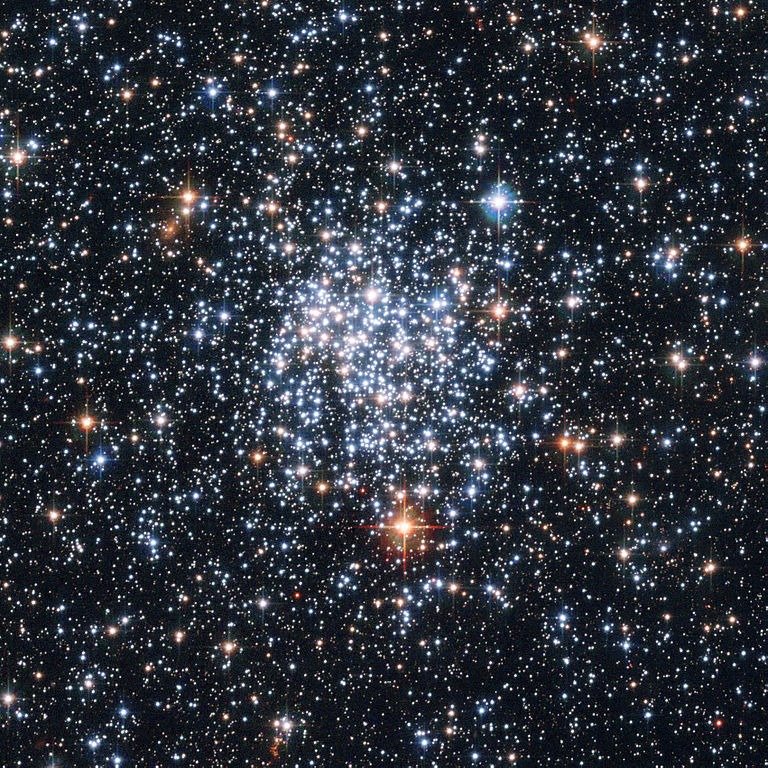Image: ESA and NASA
Acknowledgment: E. Olszewski (University of Arizona)
The stars are not born alone. They form among other stars in big groups, or star clusters, inside giant molecular clouds of gas and dust.
That means that our Sun, just like any other star, came from a big family. But then where are all the Sun’s siblings?
In our Milky Way galaxy we see two main types of star clusters:
Open cluster is a group of hundreds of young stars loosely held together by gravity. The stars in an open cluster usually break apart hundreds of million of years after the birth. These clusters occupy the disk of our Galaxy. We observe more than a thousand of them in the Milky Way!
Globular cluster, on the other hand, is a group of hundreds of thousands of old stars strongly held together by gravity. Globular clusters stay gravitationally bound. They occupy the halo of the Milky Way and we observe less than 200 of them in our galaxy.
Astronomers think that the Sun was born about 4.57 billion years ago in the open star cluster that contained thousands of members. It has long since disintegrated, thanks to the gravitational tug of the stars from outside the cluster. Now all the Sun’s brothers and sisters carry on orbiting the center of the Galaxy scattered all over the Milky Way.
For the past decade many groups of researchers attempted to identify solar siblings.
Why is it so important, you may ask? With billions of fascinating stars in the Milky Way, why look for those particular few thousands that were born in the close proximity to the Sun? And how can one possibly identify the right ones? It’s like looking for a needle in a haystack!
Why look for the solar siblings
Studying the solar siblings will help us better understand the conditions that existed in the Sun’s birthplace. It might give us some clues to the biggest question of all, the origin of life! It would be extremely interesting to see what kind of planetary systems (if any) these stars have. And especially what kind of rocky planets there are. Many scientists think that the rocky planets orbiting solar siblings can be the best places to look for alien life.
How to choose the Sun’s sibling candidates
All the stars in the Sun’s cluster were born out of the same giant molecular cloud material. That is why they all share the same chemical composition and have similar age. Moreover, it is possible by studying the star motion in the present to reconstruct its orbits in the past. And hence to see where the star used to be around 5 billion years ago.
Therefore to check whether the star is related to the Sun, we need to know its age, motion and chemical makeup. Sounds easy! Or…is it?
Motion?
Full sky star catalogs contain information about positions, distances and velocities of stars. This information can help us trace stars back to the place of their origin.
- The famous Hipparcos catalog, the result of four years of observations with ESA Hipparcos observatory, contains the high-precision information about 120 000 stars.
- Its successor, the now-operating ESA GAIA observatory, is the biggest and the most precise catalog to date. The most recent GAIA data release in April 2018 (see DR2) contain over a billion of stars!
Composition?
Studying a star’s chemical composition is possible with an instrument called spectrograph, that breaks the light from a star into spectrum, mush as a prism separates the visible light into different colours. The spectrum tells us what chemical elements are present in a star and how much.
The most ambitious spectroscopic survey at the moment is GALAH survey carried out by Australian Astronomical Observatory. In April 2018 GALAH team released the spectroscopic data about nearly 350 000 stars!
As you see, the information is open and easily accessible, so if you feel like helping the scientists look for the Sun’s family, don’t let us stop you!
Age?
Stars are fascinating but predictable objects. Their evolution is governed by initial mass and chemical composition. Therefore to determine the age of a star scientists use theoretical models of star evolution and compare them with a few known characteristics of a particular star (see “padova isochrones”). In practice, though, such age evaluations are model-dependent and not very accurate.
So…where are the Sun’s siblings?
As we see, the success of the search for the Sun’s relatives relies on the high precision of the data and one’s ability to proceed the huge volumes of information. As we to continue to add new stars to the star catalogs and improve the knowledge about chemistry and kinematics of the existent ones, our chances of identifying solar siblings dramatically increase.
At the moment many astronomers agree, that one of the most reliable candidate for the Sun’s sibling is a star HD 162826 (also known as HIP 87382) situated 110 light years away from the Earth. Though according to the authors of this paper that came out in October, the star HD186302 (HIP97507), situated 184 light year away from Earth, is more likely to share the Sun’s DNA.
The other candidates mentioned in the literature include HIP21158, HIP47399 and HIP92831.
And so the search for the Sun’s brothers and sisters goes on!
Any questions? Let our inflatable planetarium team know or visit one of our space dome shows!

